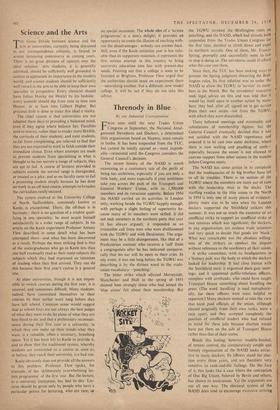Threnody in Blue
By our Industrial Correspondent
El ROM now until the next Trades Union jr Congress in September, the National Amal- gamated Stevedores and Dockers, a determined little organisation based on Stepney, must remain in limbo. It has been suspended from the TUC, but cannot be totally ejected or—most improb- ably—reinstated until the Congress considers the General Council's decision.
The recent history of the NASD is worth examining as a cautionary tale of the perils of being too ambitious, especially if you are only a little body, and more especially if your ambitions take you across the path of the Transport and General Workers' Union, with its 1,300,000 members and its voracious appetite. Before 1954 the NASD carried on its activities in London only, working beside the TGWU happily enough, with perhaps a slight feeling of superiority be- cause many of its members were skilled. It did not seek members in the northern ports that year (it has alWays argued); it responded to an irresistible call from men who were disillusioned with the TGWU and with Deakinism. The .argu- ment may be a little disingenuous, like that of a Presbyterian minister who receives a 'call' from a congregation after he has indicated- unequivo- cally that his ear will be open to their cries. In any event, it was not long before the TGWU was describing it by the dirtiest word in the trade- union vocabulary—`poaching.'
The bitter strike which affected Merseyside, Manchester arid Hull in the spring of 1955 showed how strongly those who had joined the 'blue union' felt about their membership. But the TGWU invoked the Bridlington rules on poaching; and the NASD, which had already been suspended from the Trades Union Congress for the first time, decided to climb down and expel its northern recruits. One of them, Mr. Francis Spring, promptly and successfully went to law to stop it doing so. The stevedores could ill afford what this case cost them.
Since then, the TUC has been seeking ways to prevent the Spring judgment thwarting the Brid- lington rules. Its first solution was to order the NASD to allow the TGWU to 'service' its mem- bers in the North. But the stevedores' executive took legal advice on this and was told that it would lay itself open to another action by mem- bers; they had, after all, signed on to get service from their own Union—not from the TGWU, with which they were dissatisfied.
There followed meetings and statements and submissions of membership figures; but the General Council eventually decided that it was not satisfied with the NASD repentance and ordered it to be cast into outer darkness, where there is now wailing and gnashing of teeth— especially because the union is not allowed to canvass support from other unions in the months before Congress meets.
The NASD has some justice in its complaint that the inadequacies of its big brother have led to all its troubles. There is no section of the TGWU where the members are more out of tune with the leadership than in the docks. The startling exodus to the blue union in the North in 1954 is only one of many pieces of evidence; plenty more was to be seen when the London dockers supported the Smithfield strikers this summer. It was not so much the existence of an unofficial strike to support an unofficial strike at two removes which was significant; the dockers, in any organisation, are, zealous trade unionists and Very quick to decide that goods are 'black.' What was remarkable was the absolute willing- ness of • the strikers to conduct the dispute without reference to the machinery of their union.
A strike committee, with its headquarters in a :Stepney pub, was the body to which the dockers looked for leadership. It had close liaison with the Smithfield men; it organised dOck-gate meet- ings; and it appointed public-relations officers, complete with armbands, who could have taught Transport House something about handling the press. (The word 'handling' is used metaphoric- ally, for these officers were most helpful to reporters.) Many dockers seemed to take the view that local paid officials of the union, although elected originally from their own ranks, were a race apart, and they accepted completely the position of unofficial leaders who had refused to stand for these jobs because election would have put them on the side of Transport House rather than that of their mates.
Beside this feeling, however muddle-headed, of remote control, the comparatively simple arid homely organisation of the NASD looks attrac- tive to many dockers. Its officers stand for elec- tion every three years, and are therefore very sensitive to rank-and-file feelings. On the face of it, this looks like a case where the conception of One Big Union, beloved by Bevin and others, has shown its weaknesses. Yet the arguments are not all one way. The electoral system of the NASD does tend to encourage excessive striving
after popularity, with a consequent unwillingness to tell the members when they are wrong.
The Bridlington rules, too, offer some protec- tion to the community, as well as to the trade- union Establishment. They are, after all, a recognition of the unfortunate fact that in a com- pletely free market many trade unionists will move constantly around looking for the highest bidder—a kind of competition that does not encourage stable industrial relations. Neither, of course, does the looseness of the TGWU's con- trol in the docks. Ultimately, it is a question of finding a new balance between democracy and responsible behaviour.



























 Previous page
Previous page